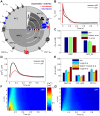In silico screening of the key cellular remodeling targets in chronic atrial fibrillation
- PMID: 24853123
- PMCID: PMC4031057
- DOI: 10.1371/journal.pcbi.1003620
In silico screening of the key cellular remodeling targets in chronic atrial fibrillation
Abstract
Chronic atrial fibrillation (AF) is a complex disease with underlying changes in electrophysiology, calcium signaling and the structure of atrial myocytes. How these individual remodeling targets and their emergent interactions contribute to cell physiology in chronic AF is not well understood. To approach this problem, we performed in silico experiments in a computational model of the human atrial myocyte. The remodeled function of cellular components was based on a broad literature review of in vitro findings in chronic AF, and these were integrated into the model to define a cohort of virtual cells. Simulation results indicate that while the altered function of calcium and potassium ion channels alone causes a pronounced decrease in action potential duration, remodeling of intracellular calcium handling also has a substantial impact on the chronic AF phenotype. We additionally found that the reduction in amplitude of the calcium transient in chronic AF as compared to normal sinus rhythm is primarily due to the remodeling of calcium channel function, calcium handling and cellular geometry. Finally, we found that decreased electrical resistance of the membrane together with remodeled calcium handling synergistically decreased cellular excitability and the subsequent inducibility of repolarization abnormalities in the human atrial myocyte in chronic AF. We conclude that the presented results highlight the complexity of both intrinsic cellular interactions and emergent properties of human atrial myocytes in chronic AF. Therefore, reversing remodeling for a single remodeled component does little to restore the normal sinus rhythm phenotype. These findings may have important implications for developing novel therapeutic approaches for chronic AF.
Conflict of interest statement
The authors have declared that no competing interests exist.
Figures








Similar articles
-
Atrial L-type Ca2+ currents and human atrial fibrillation.Circ Res. 1999 Sep 3;85(5):428-36. doi: 10.1161/01.res.85.5.428. Circ Res. 1999. PMID: 10473672
-
Cellular and molecular mechanisms of atrial arrhythmogenesis in patients with paroxysmal atrial fibrillation.Circulation. 2014 Jan 14;129(2):145-156. doi: 10.1161/CIRCULATIONAHA.113.006641. Epub 2013 Nov 18. Circulation. 2014. PMID: 24249718 Free PMC article.
-
Chronic myocardial infarction promotes atrial action potential alternans, afterdepolarizations, and fibrillation.Cardiovasc Res. 2013 Jul 1;99(1):215-24. doi: 10.1093/cvr/cvt087. Epub 2013 Apr 8. Cardiovasc Res. 2013. PMID: 23568957 Free PMC article.
-
[Biology of the substrate of atrial fibrillation].Biol Aujourdhui. 2012;206(1):5-9. doi: 10.1051/jbio/2012004. Epub 2012 Apr 3. Biol Aujourdhui. 2012. PMID: 22463991 Review. French.
-
Dynamic remodeling of intracellular Ca²⁺ signaling during atrial fibrillation.J Mol Cell Cardiol. 2013 May;58:134-42. doi: 10.1016/j.yjmcc.2012.12.020. Epub 2013 Jan 5. J Mol Cell Cardiol. 2013. PMID: 23298712 Review.
Cited by
-
Understanding PITX2-Dependent Atrial Fibrillation Mechanisms through Computational Models.Int J Mol Sci. 2021 Jul 19;22(14):7681. doi: 10.3390/ijms22147681. Int J Mol Sci. 2021. PMID: 34299303 Free PMC article. Review.
-
Understanding the Beat-to-Beat Variations of P-Waves Morphologies in AF Patients During Sinus Rhythm: A Scoping Review of the Atrial Simulation Studies.Front Physiol. 2019 Jun 18;10:742. doi: 10.3389/fphys.2019.00742. eCollection 2019. Front Physiol. 2019. PMID: 31275161 Free PMC article.
-
Heterogeneous Effects of Fibroblast-Myocyte Coupling in Different Regions of the Human Atria Under Conditions of Atrial Fibrillation.Front Physiol. 2019 Jul 4;10:847. doi: 10.3389/fphys.2019.00847. eCollection 2019. Front Physiol. 2019. PMID: 31333496 Free PMC article.
-
Proarrhythmia in the p.Met207Val PITX2c-Linked Familial Atrial Fibrillation-Insights From Modeling.Front Physiol. 2019 Oct 22;10:1314. doi: 10.3389/fphys.2019.01314. eCollection 2019. Front Physiol. 2019. PMID: 31695623 Free PMC article.
-
Computational modeling: What does it tell us about atrial fibrillation therapy?Int J Cardiol. 2019 Jul 15;287:155-161. doi: 10.1016/j.ijcard.2019.01.077. Epub 2019 Jan 25. Int J Cardiol. 2019. PMID: 30803891 Free PMC article. Review.
References
-
- Pedersen OD, Abildstrøm SZ, Ottesen MM, Rask-Madsen C, Bagger H, et al. (2006) Increased risk of sudden and non-sudden cardiovascular death in patients with atrial fibrillation/flutter following acute myocardial infarction. Eur Heart J 27: 290–295. - PubMed
-
- Allessie M, Ausma J, Schotten U (2002) Electrical, contractile and structural remodeling during atrial fibrillation. Cardiovasc Res 54: 230–246. - PubMed
-
- Nattel S, Burstein B, Dobrev D (2008) Atrial Remodeling and Atrial Fibrillation: mechanisms and implications. Circ Arrhythm Electrophysiol 1: 62–73. - PubMed
-
- Ehrlich JR, Nattel S (2009) Novel approaches for pharmacological management of atrial fibrillation. Drugs 69: 757–774. - PubMed
Publication types
MeSH terms
Substances
LinkOut - more resources
Full Text Sources
Other Literature Sources
Medical

